Introduction to the Mustool MT92 or Bside ADM92
The delivery
Both versions of this multimeter look completely the same. The first difference is that the MT92 is housed in a light grey enclosure and the ADM92 in a black housing. The second difference is that the ADM92 is slightly more expensive than the MT92. We bought and tested a Mustool MT92.
The meter comes in a sturdy cardboard box (18.0 cm x 11.3 cm x 4.5 cm) along with two test leads, a carry bag, a thermocouple cable for measuring temperatures and a manual. This manual has 22 pages, is bilingual (English/Chinese) and very extensive and clearly written. However, the font size is very small, which makes it difficult to read the text quickly. The two test leads are of a good quality, are well insulated, have a sharp point and are 95 cm long.
The meter requires two 1.5 V batteries of type AAA, these are not included.
 |
| The packaging and contents of this cardboard box. (© 2019 Jos Verstraten) |
We are less satisfied with the quality of the thermocouple cable. This cable also has a length of 95 cm, but the two banana plugs are soldered with very thin wires to the actual thermocouple cable. These joints are only finished with a piece of heatshrink tubing of 25 mm length. The chance that one of the wires breaks during intensive use is quite high.
 |
| The thermocouple cord doesn't look robust. (© 2019 Jos Verstraten) |
The MT92 measures up to 6,000 counts or up to 9,999 counts The automatic switch ensures that the 6,000 display range is maximized. For example, when the measured DC voltage is increased, the display switches automatically to 06.09 V at 6.095 V. In the opposite direction, the display switches to 5.908 V at 05.90 V. As is usually the case with this type of multimeter, three measurements are taken per second.
The available measuring ranges are:
- DC voltages: 6.000 V ~ 60.00 V ~ 600.0 V ~ 1,000 V
- AC voltages: 6.000 V ~ 60.00 V ~ 600.0 V ~ 750 V
- Direct currents: 60.00 mA ~ 200.0 mA
- Alternating currents: 60.00 mA ~ 200.0 mA
- Resistors: 600.0 Ω ~ 6.000 kΩ ~ 60.00 kΩ ~ 600.0 kΩ ~ 6.000 MΩ ~ 60.00 MΩ
- Capacitors: 9.999 nF ~ 99.99 nF ~ 999.9 nF ~ 9.999 μF ~ 99.99 μF ~ 999.9 μF ~ 9.999 mF
- Frequencies: 9.999 Hz ~ 99.99 Hz ~ 999.9 Hz ~ 9.999 kHz ~ 99.99 kHz
- Temperatures: 500 °C
The specified accuracies
- DC voltages: ±(0.5 % + 3 counts)
- AC voltages: ±(0.8 % + 3 counts)
- Direct currents: ±(0.8 % + 3 counts)
- Alternating currents: ±(1.0 % + 3 counts)
- Resistors: ±(0.8 % + 3 counts) to ±(1.2 % + 30 counts)
- Capacitors: ±(4.0 % + 10 counts)
- Temperatures: ±(2.0 % + 2 counts)
- Frequencies: unspecified
The other technical specifications
- Maximum input voltage DC: 1,000 V
- Maximum input voltage AC: 750 Vrms
- AC voltage measurement: true RMS
- Frequency range AC voltage measurements: 45 Hz ~ 1,000 Hz
- Input resistance voltage measurements: 10 MΩ typical
- Voltage drop during current measurements (burden voltage): 420 mV at 100 mA
- Non-contact AC voltage detection: yes, LED and buzzer
- Live wire detection: yes
- Diode test: 3.3 V max. conductivity voltage
- Continuity measurement: 50 Ω max. with buzzer
- Digit height: 15 mm
- Display backlight: switchable
- Automatic switch-off: yes, after 15 minutes
- Weight (with batteries): 116 g
- Power supply: 2 x 1.5 V, type AAA
- Operating time with new batteries: 600 hours typical
- Battery control: via display
The dimensions of the meter
In the figure below we have summarized all the views and dimensions of the MT92. On the back, next to the battery compartment, there is a metal clip which you can use to hook the meter into your pocket or to your belt. The lid of the battery compartment is fixed with one screw. On one side there is a notch in the housing where you can clamp one of the measuring probes. This is intended for the so-called 'live check', which allows you to trace the live wire in a wall socket with one probe. An alternative to the well-known neon voltage detector, in other words.
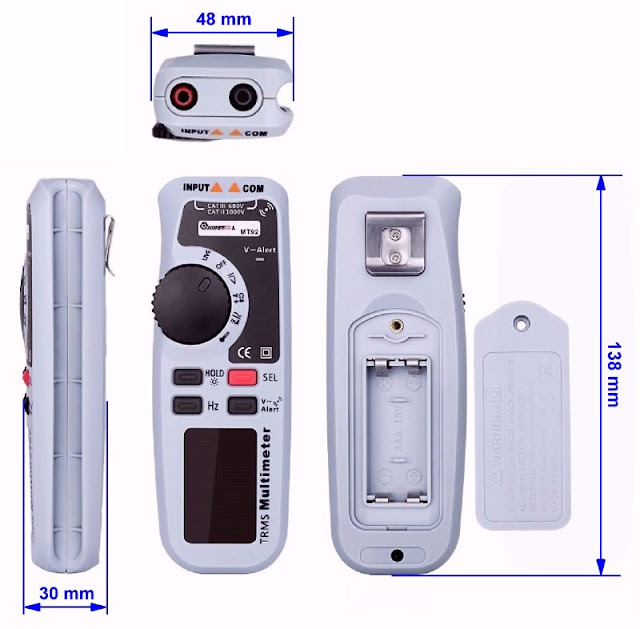 |
| The views and dimensions of the MT92. (© 2019 Jos Verstraten) |
The meter has four push buttons and a rotary switch, which allows you to operate the MT92 comfortably.
- Function switch
This one has five positions:
- LIVE: Detects a live wire with one measuring probe.
- OFF: Turns the meter off.
- V: Measures DC and AC voltages.
- Ohms: Measures resistors, continuity, capacitors and diodes.
- mA: Measures alternating and direct current.
- Thermometer: Measures temperatures. - SEL
Selects AC/DC for voltages and currents and one of the four measurement quantities of the Ohms mode of the function switch. The selected quantity is shown on the display. - V~Alert
Enables the alarm to detect electrical wires in walls. The alarm works with an LED and a buzzer. - HOLD
A short press on this button freezes the display. Pressing this button for more than one second switches the backlight of the display on or off. - Hz
Turns the frequency measurement on, but you must first set the meter to measure AC voltages or currents using the function switch and the SEL push button.
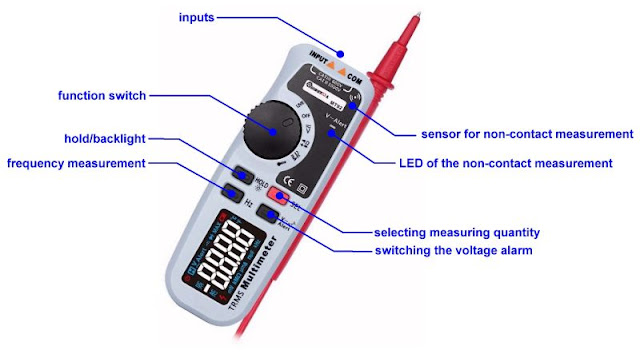 |
| The controls of the MT92. (© 2019 Jos Verstraten) |
After unscrewing the battery compartment cover and the metal mounting clip, you can remove a few screws. You can separate the two parts of the plastic housing and then admire the PCB. What is immediately noticeable are two large, yellow components that are soldered in the holes where the reference designators F1 and F2 are mentioned. These are clearly not fuses, but probably PTC's that are used together with the TVS-diode D1 to protect the inputs against high currents or voltages. A TVS-diode (Transient Voltage Suppression) is a bi-directional diode that breaks through when the voltage across the diode is greater than a certain threshold value.

At the bottom of the PCB you can see two rather large resistors R4a and R4b of 5 MΩ. These are the input resistors of the voltage input. This resistor is split because of the maximum voltage of 1,000 Vdc which, according to the specifications, you can connect to the meter.
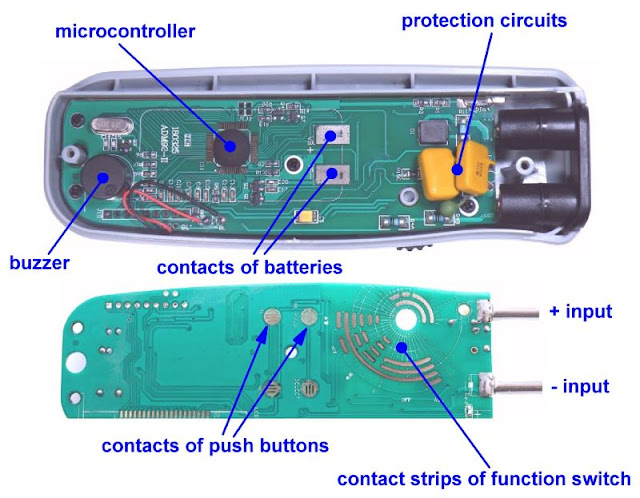 |
| The two sides of the PCB. (© 2019 Jos Verstraten) |
The Mustool MT92 multimeter tested
Measurement of DC voltages
For testing the accuracy of multimeters in measuring DC voltages we have available a voltage reference AD584LH from Analog Devices. The table below shows the performance of the MT92. The specified accuracy of ±(0,5 % + 3 counts) is thus easily achieved.
Also when measuring very small DC voltages, in the order of magnitude of 10 mV to 100 mV, no deviations were found that are larger than the specified ones.
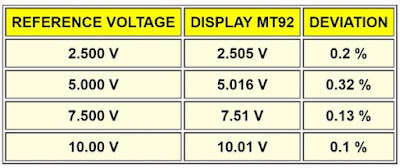 |
| The accuracy of DC voltages measurements. (© 2019 Jos Verstraten) |
For this purpose, we use our digitally adjustable function generator, tuned to 50 Hz, with a multimeter VC650BT as a reference. In the table below, the measurement results up to 7.00 Vrms are summarized. Unfortunately our generator does not go any higher. Again, the deviations appear to be within the specifications. The mains voltage of 240.41 V was measured by the MT92 as 240.2 V, a deviation of only 0.087 %. The results are very convincing and prove that the MT92 measures AC voltages very accurately.
 |
| The accuracy of AC voltages measurements. (© 2019 Jos Verstraten) |
We measured the frequency range with a sine wave voltage of 5.00 Vrms. The result is shown in the graph below. From this you can conclude that you can fully rely on the readings of the MT92 when measuring AC voltages with frequencies between 20 Hz and 2 kHz. This again is much better than the specifications promise.
 |
| The frequency range when measuring AC voltages. (© 2019 Jos Verstraten) |
According to the specifications, the MT92 calculates the RMS value of AC voltages. The RMS value (Vrms) of an AC voltage is equal to a DC voltage that generates the same thermal power in a resistor as the considered RMS value. We have provided the MT92 with various signal forms with a frequency of 50 Hz and set the amplitude of the function generator so that in all cases our reference meter indicated an RMS value of 5,000 Vrms. These results are also excellent, see the table below.
 |
| The measured RMS value of various signal forms. (© 2019 Jos Verstraten) |
The MT92 has just two current ranges with a maximum of only 200 mA. That is a pity and a strange decision of the designers. A current range of up to 1 A could have been integrated into this beautiful meter without much extra cost. Of course, we have checked the accuracy of the measurement of this parameter. The results are summarized in the table below.
 |
| Accuracy when measuring direct currents. (© 2019 Jos Verstraten) |
For testing the accuracy of resistor measurements, a resistor array of six resistors with a tolerance of ±0.1 % is available. The results are summarized in the table below.
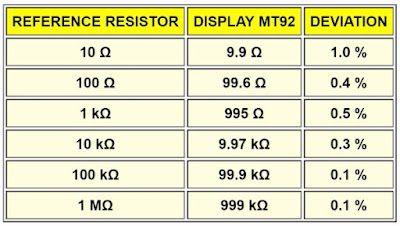 |
| The accuracy when measuring resistors. (© 2019 Jos Verstraten) |
Eight capacitors with a tolerance of ±1 % are available for this purpose. The measurement results, summarized in the table below, show that the MT92 is not suitable for measuring small capacitors at all. If you connect a 470 pF capacitor, the meter will not recognize this and will not start a measurement cycle. Below 10 nF, the measurement errors are unacceptably large, which makes this meter rather unsuitable for measuring the capacitors that you often encounter in electronic circuits in practice.
 |
| The accuracy when measuring capacitors. (© 2019 Jos Verstraten) |
Testing the accuracy of temperature measurements is difficult for us, because the laboratory meter that we use as a reference itself has a fairly large error, namely ±(3,0 % + 20 counts). According to the specifications, the MT92 should do better with ±(2,0 % + 2 counts). The MT92 measures temperatures with a resolution of only 1 °C. The data in the table below should therefore be considered as an approximation. We have not calculated a percentage deviation because this is completely meaningless. In any case, this function of the MT92 is good enough for checking the temperature of electronic components on a circuit board. Thanks to the very small thermocouple, little heat will leak out of the component and you can measure a realistic value of a component's temperature.
 |
| Comparison of the measurements of two temperature meters. (© 2019 Jos Verstraten) |
Because you often have to deal with TTL signals in practice, we have tested the frequency response of the MT92 with such a signal: a symmetrical pulse with an amplitude of 5.0 V. This is achieved very accurately and without problems up to the specified measuring range of 99.99 kHz.
With a sinusoidal signal of 1 Vrms at the input, the MT92 measures the frequency accurately to 35 kHz. At higher frequencies the readout becomes unreliable.

The live wire detection (live check)
The intention is that if you set the meter to the 'LIVE' position and you connect the red test wire with the live of the mains supply, the meter will beep and the alarm LED will flash. That happens, but with some wall sockets the same thing happened when touching the neutral wire. We therefore advise you not to use this function in practice, an old-fashioned voltage detector with neon tube is much more convenient and reliable.
Our opinion on the Mustool MT92
For most applications in the electronics measuring practice, the MT92 is perfectly usable and meets its specifications. It is a pity that the current capacity is limited to 200 mA and that small capacitors are not measured or are measured inaccurately. The meter is easy on the hand and is therefore an excellent tool for a service technician. A disadvantage of the special design, however, is that the MT92 does not feel very much at home on a table. Lying flat on a table, the meter is not easy to read and the texts on the buttons are in the wrong direction.

MUSTOOL MT92 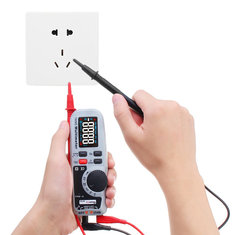
|
BSIDE ADM92 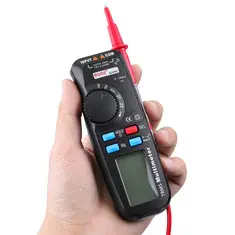
|
